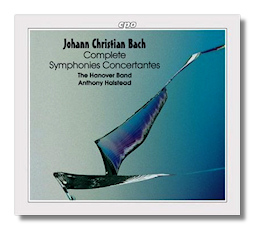
The Internet's Premier Classical Music Source
Related Links
- J.C. Bach Reviews
- Latest Reviews
- More Reviews
-
By Composer
-
Collections
DVD & Blu-ray
Books
Concert Reviews
Articles/Interviews
Software
Audio
Search Amazon
Recommended Links
Site News
 CD Review
CD Review
Johann Christian Bach

Complete Symphonies concertantes
- Fortepiano Concerto in G Major (C 60b)
- Violin Concerto in C Major (C 76b)
- Flute Concerto in D Major: Larghetto (C 34)
- Cadenza for Oboe, Violin, Viola & Cello in C Major (attr.to Symphonie concertante in G, C 45)
- Symphonie concertante for 2 Violins & Oboe in E Flat Major (C 33a)
- Symphonie concertante for 2 Violins & Cello in G Major (C 32)
- Symphonie concertante for 2 Violins & Cello in E Flat Major (C 42)
- Symphonie concertante for Violin & Cello in B Flat Major (C 46)
- Symphonie concertante for Oboe & Bassoon in F Major (C 38)
- Symphonie concertante for 2 Violins in D Major (C 35)
- Symphonie concertante for 2 Violins, Cello & Flute in E Major (C 44b)
- Symphonie concertante for 2 Clarinets, Bassoon, 2 Horns & Flute in E Flat Major (C 41)
- Symphonie concertante for Violin & Cello in A Major (C 79)
- Symphonie concertante for 2 Violins & Cello in C Major (C 36b)
- Symphonie concertante for Flute, Oboe & Bassoon in E Flat Major (C 37)
- Symphonie concertante for 2 Violins, Cello & Flute in G Major (C Inc 5)
- Symphonie concertante for 2 Violins & Cello soli in C Major (C 36a)
- Symphonie concertante for 2 Flutes, 2 Violins & Cello in D Major (C 39)
- Symphonie concertante for 2 Oboes, 2 Horns, 2 Violins, 2 Violas & Cello in E Flat Major (C 40)
- Symphonie concertante for Oboe, Violin, Cello & Fortepiano in B Flat Major (C 48)
- Symphonie concertante for Flute, Oboe, Violin & Cello in C Major
The Hanover Band/Anthony Halstead
CPO 777292-2 DDD 6CDs: 57:21, 52:26, 52:37, 65:42, 54:47, 69:32
The symphonie concertante (or, to use the more common Italian variant, sinfonia concertante) is (arguably) the Classical descendant of the Baroque concerto grosso. As its name suggests, it is somewhere between a symphony and a concerto. Soloists, usually more than one, play an important role in this genre, but they are not the centers of attention as they are in a concerto. In other words, there is contrast between the one (or several) and the many, but not a competition or a constant dialogue. Paris was the first musical center in which performances of works in this genre flourished.
Johann Christian Bach (1735-1782) is more famously known as "the London Bach" because he spent the latter part of his career in that city. Nevertheless, his symphonies concertantes were composed for Parisian tastes. He wrote well over a dozen works in this genre, and possibly inspired Mozart to compose his more famous symphonies concertantes, one for violin and violin, and the other for four wind instruments. Only a few of them were publishing during Bach's lifetime. Today, the manuscripts reside in London's British Library.
This six-CD set is part of cpo's 22-CD collection of Johann Christian Bach's complete extant orchestral works. CPO claims that these six discs contain the composer's complete symphonies concertantes, although it wouldn't be surprising if new ones were discovered or authenticated, or if the authenticity of some of them were to be challenged. Some of them also exist in other versions. (For example, the very first work listed here also exists in a version as a keyboard concerto.) First recording status is claimed for three of these works. These six discs were recorded between 1998 and 2001, and originally released separately; this is a simple repackaging with all six CDs inserted into a slipcase.
No slight is intended to French audiences from the second half of the 1700s, but they were less interested than their cousins to the west in hearing music that expressed painful or agitated emotions. (The Sturm und Drang movement was not a French phenomenon, after all.) Symphonies concertantes written for Paris, including those by Johann Christian Bach, generally are charming and mellifluous, not deep and emotionally varied. One musicologist's study of about 570 symphonies concertantes from this era reveals that less than a handful of them are in a minor key. Still, there are surprises. The Symphonie Concertante in C, with 2 violins and cello, contains a poignantly beautiful middle movement in C minor. Small instances of "bittersweetness," if you will, make the entire body of work more rewarding than it would have been otherwise. For whiling away the hours, though, this is prime stuff.
The triple-threat Anthony Halstead conducts these performances, and also is the fortepiano soloist when that instrument is required. He might be familiar to some for his work as a hornist, although here he is not heard in that capacity. The Hanover Band is a period instrument ensemble founded in 1980, and that first attracted international attention for its Naxos recordings (with conductor Roy Goodman) of Beethoven's symphonies. Those Beethoven discs could be a little on the feisty side. The more recent Hanover Band has a more mellow sound, and the best single-word description for the present performances is "refined." There's a stylishness here that does not call attention to itself, and everything goes smoothly over the course of nearly six hours of listening. In fact, some listeners might want a little more danger in the music-making. If there's a deficiency in that element, though, it has as much to do with Johann Christian Bach as with Halstead and the Hanover Band.
The engineering is excellent, and each disc includes Ernest Warburton's thorough and scholarly (yet not stuffy) annotations about the music.
Copyright © 2007, Raymond Tuttle




















